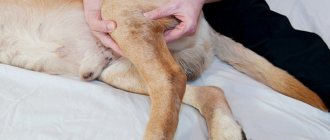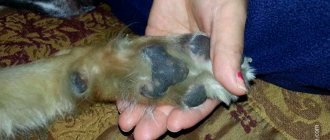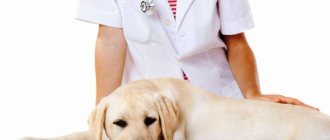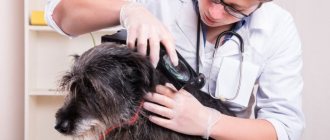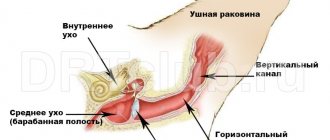What is phlegmon
Phlegmon (from the Greek “phlegmone” - heat, inflammation) is a purulent inflammation of loose tissue, covering a wide area and having no clear boundaries.
Cellulitis in dogs is a common disease. Sometimes a fight may occur between dogs while walking, or the dog may accidentally injure itself in some other way. A huge amount of pyogenic microflora can get into the wounds, for example, Staphylococcus aureus or Proteus and others. Much attention should be paid to small wounds; they should not be left unchecked; a seemingly small bite often leads to serious consequences. You will ask why? In the area of a small bite, a rather large subfascial cavity is formed, where conditions favorable for putrefactive microflora develop. After a fight between dogs or other injuries, it is better to immediately contact a veterinary clinic to receive first aid. If this is not done or first aid is provided to the dog in the wrong way, then phlegmon often forms at the site of the bite.
Clinical signs of cellulitis in dogs
Every day the dog begins to feel increasing discomfort in the area of the formed phlegmon. In the shortest possible time, characteristic clinical signs of phlegmon appear, such as refusal to feed, increased temperature of the tissues in the wound area and the whole body. Increased heart rate and breathing. There is a deterioration in general condition. In the area of the wound, skin tension is noted, its borders are smoothed. Subsequently, the swelling becomes limited, and foci of necrosis appear. At the same time, the amount of infiltrate increases - cellular elements accumulated at the site of phlegmon, to which lymph and blood are mixed.
Treatment of cellulitis in dogs
Treatment of phlegmon in dogs takes a long time and is a very expensive process. There are 6 stages in the development of phlegmon, for each of which there are individual treatment methods.
- The first stage is an increase in local temperature, swelling, development of local edema;
- The second stage – cellular infiltration occurs, a cellular barrier is formed;
- The third stage is the beginning of abscess formation, progression of necrosis;
- The fourth stage - the completion of abscess formation and subsequent maturation of phlegmon;
- Fifth stage – tissue granulation occurs;
- The sixth stage is scarring of the affected areas of the skin.
In the first three stages, treatment is carried out using novocaine blockades with an antibiotic. A course of systemic antibiotics is also prescribed. At stages 3 to 5, drugs are used that support and normalize the activity of the whole organism, as well as agents that promote desensitization and remove necrotic tissue areas. Sufficiently large incisions are made to ensure unimpeded drainage of exudate. Then the wound is washed with various antiseptic solutions, and ointments with antibacterial and healing properties are placed into the cavity. A very important point is that the treatment must be comprehensive!
Symptoms of cellulitis in dogs
Cellulitis that appears in a pet is characterized by a number of specific symptoms. The owner can suspect the development of a pathological process based on the following signs:
- increase in local temperature;
- the occurrence of painful sensations in the area where the purulent-necrotic process is located;
- pronounced swelling at the location of the phlegmon, spreading with great speed to nearby tissue structures;
- redness of a skin area that does not have clear boundaries (spread inflammation).
The animal suffers from severe headaches, and fever may be observed against the background of a general change in body temperature. In the deep form of phlegmon, swelling and edema at the location of the pathology are absent.
Failure to provide necessary assistance in a timely manner leads to the inevitable development of complications.
Serious swelling occurs, indicating inflammatory processes affecting the lymphatic vessels. Often, advanced forms of phlegmon are characterized by erysipelas, thrombophlebitis, and sepsis (blood poisoning).
If the development of phlegmon is suspected, every attentive and loving owner should seek help from a veterinary clinic. The specialist will carefully conduct the necessary research and determine further treatment tactics.
To diagnose the phlegmonous process, palpation of the affected area and a thorough clinical examination are performed. It is imperative to carry out differential diagnosis to distinguish the type of inflammation - abscess, phlegmon, boil.
The patient needs to donate blood for general and biochemical analysis. The presence of unformed forms of leukocytes in the results indicates diffuse purulent inflammation. The diagnosis is confirmed on the basis of a clinical examination - the presence of swelling, changes in body temperature, pain at the site of injury.
Cellulitis in dogs
Pathologies of the subcutaneous tissue in our four-legged pets are sometimes characterized by severe inflammation of soft tissues, irreversible necrotic processes and severe intoxication, leading to blood poisoning and death of the beloved dog.
One of these insidious diseases is phlegmon in dogs - an acute purulent inflammatory disease of loose tissue, accompanied by irreversible necrotic processes. The causative agent of the pathology is putrefactive and pyogenic microflora or chemical poisons that penetrate the subcutaneous tissue during open injuries, operations in violation of antiseptic rules, or through the hematogenous route from affected organs. Unlike an abscess or boil, the inflammatory focus of phlegmon does not have clearly defined boundaries, due to which healthy tissue is constantly involved in the pathological process.
At the site of penetration of an infection or a chemical substance, a painful swelling of the soft tissues forms; the pathology is accompanied by fever and severe intoxication of the dog. At the site of edema, necrotic foci form, melting of soft tissues and penetration of pathogenic microflora into healthy tissues and the circulatory system, this condition is dangerous due to the formation of multiple abscesses in internal organs, sepsis, vascular thrombosis and death of the animal.
Causes of phlegmon formation in dogs
A pathological inflammatory process refers to acute purulent conditions, often accompanied by damage to tissue structures, up to their necrosis. Necrosis affects the loose part of the hypodermis with a pronounced tendency for pus to spread throughout the tissues. It is this fact that distinguishes phlegmon from a developing abscess, clearly limited by the capsule.
There are many reasons for the development of phlegmon in a dog, but the main factor is the penetration of pathogenic bacterial microflora into the wound surface. When the integrity of the skin is damaged, pyogenic microflora penetrates deep into the tissue, actively multiplying and capturing new areas of healthy tissue.
The greatest danger of developing phlegmon is in dogs involved in skirmishes with their relatives. Fights between dogs lead to lacerations and bite wounds. Once on the wound surface, pathogenic microflora begins to move through the bloodstream and lymphatic system into nearby healthy tissues, provoking the development of a phlegmonous process.
Microorganisms that provoke the development of an infectious process in the subcutaneous fatty tissue of a dog are most often staphylococci and streptococci. Further migration of pyogenic microflora and the exudate itself depends on a host of factors.
First of all, a sharp decrease in the body’s defenses negatively affects the development of the pathological process. The animal, often malnourished or forced to starve, becomes emaciated. Chronic diseases and serious intoxications of the body can provoke a sharp decrease in immunity. There are the following main types of phlegmon in dogs: anaerobic, putrefactive and purulent.
The anaerobic form of the pathological process is characterized by the development of serous inflammatory processes in the area of soft tissue structures. Accompanying anaerobic phlegmon is the phenomenon of necrosis and the formation of specific gas bubbles in the area of the affected tissue.
In the putrefactive form of the pathology, multiple necrotic areas form in the area of the subcutaneous fatty tissue of the dog. Under the influence of pathogenic bacterial microflora, a kind of tissue melting occurs. Putrefactive phlegmon is also characterized by the accumulation of a large amount of purulent exudate, which has an unpleasant, often fetid odor, causing attacks of nausea.
Cellulitis, provoked by bacterial microflora, rarely occurs as an independent disease. Most often, phlegmon is a kind of complication against the background of abscesses or boils that were not treated in a timely manner.
The purulent exudate formed during the development of an abscess begins to look for a way out, breaking not outward, but into the deep tissues. A rupture of the abscess capsule is the beginning of the development of phlegmon, characterized by diffuse purulent inflammation.
There are a number of the following reasons that can provoke the development of a diffuse inflammatory process, accompanied by phenomena of necrosis:
- Mechanical damage to the skin . Serious large wound surfaces are the entrance gates for various types of infections. The greatest risk of developing phlegmonous inflammation occurs with stab wounds received by animals.
- Infection of small surfaces . Mechanical damage that provokes a violation of the integrity of the skin becomes the cause of infection in the wound. All wounds, even the most minor ones, must be treated with special antiseptic solutions.
- Secondary pathologies . Not only wounds received during a fight with relatives can provoke the development of phlegmon in a dog. The risks of developing a purulent-necrotic process increase in animals with long-term dermatitis, advanced forms of purulent arthritis, abscesses and inflammation of the gums. Secondary phlegmon is characterized by the activation of pathogenic bacterial microflora, which came not from the environment, but from the body itself through the circulatory or lymphatic system.
- Action of active irritants. Long-term exposure to various substances of chemical origin, including medications. A factor that provokes the development of phlegmon in a pet may be a disrupted process of administering sodium chloride (saline solution). A purulent-necrotic process can be triggered by contact with the skin of substances such as turpentine or gasoline. Tissue structures are destroyed, up to the death of hypodermal cells.
Veterinarians agree that with normal functioning of the immune system, the risks of developing dangerous inflammations in the body are reduced to minimal values. Weakened immunity is always a cause for concern, because the defense does not work even with minor damage.
At risk for the development of various inflammatory processes provoked by pathogenic microflora are small puppies, elderly dogs and animals with chronic pathologies of internal organs.
Types of phlegmon
- By localization - subcutaneous, subfascial, mucous, intermuscular, parachondral;
- According to the nature of the exudate - purulent, putrefactive, serous, purulent-hemorrhagic, gas;
- According to the nature of occurrence - primary and secondary.
Primary phlegmons arise as a result of a violation of the integrity of the skin during injuries, dog fights, operations, contact with open soft tissues of chemicals, secondary phlegmons are a complication of acute purulent diseases: abscesses, boils, carbuncles, purulent inflammation of joints and bones, infectious diseases.
The causes of phlegmon formation in dogs are:
- Injuries, wounds, operations with insufficiently sterilized instruments;
- Purulent diseases of the skin, joints and bones;
- Bacterial, fungal and parasitic diseases;
- Unbalanced diet;
- Oncology;
- Lack of vitamins;
- Metabolic disease;
- Age.
The disease is most often observed in elderly or young dogs, weakened pets, when feeding and maintenance conditions are violated, so the immune system cannot cope with pathogenic microflora.
Phlegmon in dogs manifests itself with a clear clinical picture:
- Formation of an extensive dense painful swelling with increased local temperature;
- Lack of appetite, depression, whining, the dog prefers to lie down;
- Increase in general body temperature to 40-41 degrees;
- Shallow breathing.
Diagnosis and treatment
To make a correct diagnosis, the dog owner must inform the veterinarian about recent injuries, fights, surgeries, and long-term illnesses of the pet. The decisive diagnostic value is puncture of the inflamed area with the release of pus.
To determine the cause of the pathology and the general condition of the four-legged patient, laboratory tests of urine and blood tests are prescribed.
Treatment of pathology is aimed at destroying pathogenic microflora and restoring the animal’s body after severe intoxication.
The initial stages of the disease are treated conservatively with the use of warm compresses, novocaine blockades, antibiotic therapy, alcohol dressings with ichthyol and camphor oil.
Necrotic lesions must be surgically removed in a veterinary clinic with complete excision of dead tissue and postoperative wound treatment. To relieve intoxication, cardiovascular drugs, drip infusions of sterile physiological solutions, antibacterial, immunostimulating drugs and vitamins are used.
Diagnosis and treatment of phlegmon in dogs
To make an accurate diagnosis, specialists carry out the following activities:
- examination of a sick animal;
- conducting laboratory blood tests;
- taking samples of fluid separated from tissue.
Treatment of phlegmon is prescribed depending on the stage of the disease and includes the following “local” procedures:
- In the first stages of the disease, alcohol-based warming compresses and treatment of problem areas with ichthyol ointment are indicated.
- When the phlegmon has managed to grow, it is necessary to remove the fluid and reduce the pressure inside the tissues. To do this, small incisions are made on the animal’s skin, which are covered with bandages with a solution of ethacridine or furatsilin.
- The advanced stage of the disease, when the skin turns black and tissue dies in areas affected by phlegmon, involves surgical intervention, which involves opening the problem areas and ensuring the outflow of fluid.
Prevention
The formation of phlegmon in a dog can be prevented by following preventive measures:
- Open injuries should be immediately washed with a solution of hydrogen peroxide; large injuries should preferably be treated in a veterinary clinic;
- It is recommended to feed your pet a balanced diet with vitamin and mineral supplements;
- It is advisable to immediately treat all infectious and non-infectious diseases of the pet;
- Once a year, it is necessary to carry out preventive examinations of the dog in a veterinary clinic with laboratory testing of urine and blood tests;
- At the first symptoms of the disease, you should immediately consult a specialist.
Cellulitis in dogs is a very serious and deadly pathology; the prognosis of the disease directly depends on the timely contact of the dog owner to specialists.
Symptoms and diagnosis
What are the symptoms of phlegmon in a dog, if observed, you should urgently take your pet to the veterinarian? Here is their main list:
- Hot and reddened swelling in the subcutaneous tissue.
- Decreased appetite.
- Apathy, indifference.
- Reluctance to move, jump, play. Any movement can cause pain, and the animal squeals and whines.
- Upon palpation, a pronounced pain reaction is noted.
- Fever accompanied by a strong increase in overall body temperature.
Be sure to tell the veterinarian about everything that contributed to the development of phlegmon: fights with other animals, surgical interventions, mention that the dog has any other diseases. This data will help the specialist make the correct diagnosis faster and more accurately. Upon examination, the veterinarian should determine whether the inflammation has a clearly defined border. A complete blood count is indicated, which reveals the total number of leukocytes. If there is a suspicion of the appearance of some kind of aggressive neoplasm (sarcoma, for example), a biopsy is necessary with subsequent study of the pathological material.
Cellulitis in dogs
Cellulitis is a serious purulent inflammation, aggravated by necrosis (death) of adipose tissue (including skin). Unlike diseases of this type, in the case of phlegmon, necrotic processes prevail over inflammatory ones. Unlike other similar diseases, such as an abscess, it does not have clear outlines. It usually originates due to the penetration of putrefactive or purulent microorganisms into the tissue. In rare cases, certain chemical exposures can trigger the disease.
Cellulitis can be primary and secondary. In the first case, the causes of the disease are wounds or closed injuries. Carbuncles, abscesses and boils, purulent arthritis, pulpitis and osteomyelitis become provoking factors that contribute to the occurrence of secondary phlegmon.
Depending on the location of the spread of the disease, phlegmon occurs:
- parachondral;
- subfascial;
- subcutaneous;
- mucous;
- intermuscular.
Based on the type of fluid released from the tissue or cavity, it can be classified as:
- purulent or purulent-hemorrhagic;
- gas;
- putrefactive;
- serous.
The course of the disease can be divided into six stages:
- at the very beginning of the disease, inflammatory swelling appears on the dog’s body;
- a cell barrier is formed;
- necrotic formations form, the process of abscess formation begins;
- the final maturation of phlegmon occurs, all necrotic processes are completed;
- granulation occurs;
- the scarring process begins.
Clinical signs of cellulitis in dogs
- At the initial stage of the disease, dense and warm swelling forms. Touching this swelling causes pain.
- The dermis at the site of the edema is tense, and you can also notice that the temperature around it is much higher than in other parts of the body.
- During illness, an animal becomes lethargic, apathetic and much less active.
- The pet's breathing and heart rate increase greatly.
- There is a complete or partial loss of appetite.
- In later stages of the disease, necrotic foci appear around the edema.
During the illness, general intoxication of the dog’s body occurs; the number of neutrophils in the blood increases, which indicates increasing leukocytosis.
It is impossible to accurately diagnose phlegmon at home, since differentiation of this disease requires a puncture, which is only possible in a veterinary clinic.
Symptoms of phlegmon
At the earliest stage of phlegmon, severe swelling
. Touching this area will cause pain in the animal. The skin on the swollen area of the body is tense, and the temperature around the swelling is significantly higher than the temperature of other parts of the body.
As the disease progresses, dogs become lethargic and much less active. In addition, the animal's breathing and pulse will increase significantly. Due to illness, there may be a complete or slight decrease in the pet’s appetite. At later stages of phlegmon development, areas of dying skin appear around the edema. During the course of the disease, complete intoxication occurs - the number of neutrophils in the blood increases, which indicates an increase in leukocytosis.
It will not be possible to make an accurate diagnosis of such a disease at home, since differentiation of phlegmon requires a puncture, which can only be done in specialized institutions.
Treatment of cellulitis in dogs
Treatment of phlegmon largely depends on what stage of the disease the animal is at.
If the disease has not had time to develop significantly (stages 1-3), warming compresses, mainly alcohol, are used. Tissue cleansing is carried out at the site of swelling. After this, the site of inflammation is lubricated with ichthyol. Antibiotics such as penicillin and streptomycin are prescribed intramuscularly to the dog. If the disease area is severely swollen, small incisions 1-1.5 cm long are made to remove interstitial fluid and reduce interstitial pressure, which are staggered at a distance of 2-3 cm from each other. The incised area is covered with a bandage containing a hypertonic solution of medium salts, ethacridine and furatsilin.
It is important to remember that one of the most important conditions for a pet’s recovery is to provide it with complete rest.
If the disease is at a late stage, the phlegmon must be opened through surgery. It allows you to open all necrotic formations and allows the infiltrate to come out. In this case, the operation is performed under complete anesthesia or immobilization of the dog. In this case, large incisions are made to ensure free flow of fluid from the tissue. The wound is powdered with various antiseptic powders; an emulsion of synthomycin and applications of Vishnevsky's liniment can be applied. In addition to opening the phlegmon in the later stages, calcium chloride and a course of antibiotics are prescribed.
To eliminate intoxication, the animal is usually prescribed intravenous glucose, and pyrogenal is used to quickly heal wounds, resolve scar tissue and form elastic scars.
No matter what stage of the disease the dog is at, if you suspect phlegmon, you should not self-medicate, but take it to the veterinarian as soon as possible.
How to properly treat cellulitis in dogs
In the development of phlegmon, there are a number of stages for which proper treatment methods have been invented. Treatment of phlegmon in a dog is based on stopping the inflammatory process and cleansing the source of damage.
- Stage 1 - swelling with inflammation forms.
- Stage 2 - a cellular barrier is created.
- Stage 3 - accumulation of pus limited by the capsule occurs, necrosis progresses.
- Stage 4 - the formation of abscesses ends, inflammation has formed.
- Stage 5 is the stage of the complex granulation process.
- Stage 6 - scar formation occurs.
At stages I–III, novocaine blockades are performed for treatment, and medications with novocaine are injected. At stages II–V, substances are determined to strengthen and normalize the functioning of the heart. At stages II–III, when the area is severely swollen, skin incisions are made to remove exudate. The incisions are covered with alcohol lotions with furatsilin solution. At stage IV, dead tissue is removed. The procedure is performed under general anesthesia or using sedatives and novocaine anesthesia. Large incisions are made to allow the fluid to escape. The wound is powdered with disinfecting powders, and applications of balsamic liniment (Vishnevsky ointment) are applied.
When scars form, it is effective to use an immunomodulator of bacterial origin to resolve them.
When there are doubts regarding the presence of a purulent inflammatory process, it is necessary to visit a veterinarian, because suppuration is dangerous due to the maturation of a septic condition and surgical intervention will be necessary for cure. Medical blood parameters should be assessed and systemic antibacterial medications should be prescribed.
